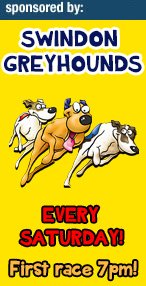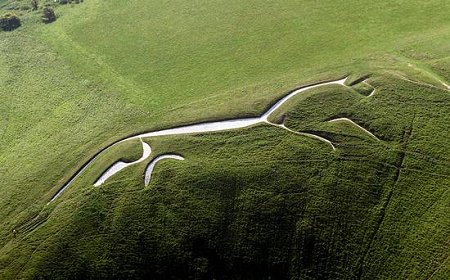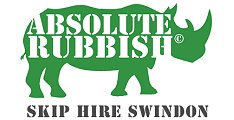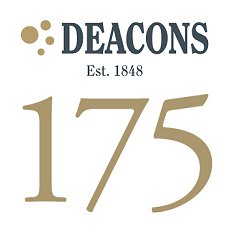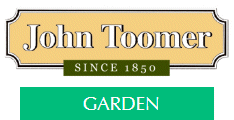The White Horses
Swindon - the home of the White Horse
No town in Britain is better situated than Swindon for enjoying the remarkable phenomenon of white horse figures which our ancestors carved into our rolling chalk hills.
Swindon is only a short drive from the six surviving Wiltshire horses, but, more importantly, it is within easy reach of the most famous white horse of all, the one at Uffington.
As splendid as the Wiltshire horses look, there is no doubt that Uffington's is easily the oldest, the most important and the most mysterious in the whole stable - and is believed to be the inspiration for all 16 other hillside horse figures to be found in Britain today.
Swindon & St. George
We investigate Dragon Hill in Uffington
While the Wiltshire horses are far more anatomically accurate than the one at Uffington, the latter captures the beauty and grace of a horse in motion perfectly, making this huge 'painting' not just a mere study of the animal, but a genuine work of art.
It is fitting that Uffington should be so different in style to its Wiltshire cousins because it comes from an altogether different age. Compared with Uffington's (see picture, right), the others are relatively modern and were cut merely for decoration and commemoration within the last 220 years. Nobody knows for sure when the Uffington horse was cut, though the general belief now is that it is probably 2000 years old and possibly even older. We know for certain that it has been there since at least 800 years ago because it is mentioned in writings dating back to the time of Henry II (1154-1189). But its siting close to the ancient track of the Ridgeway and the earthwork known as Uffington Castle suggests it was a beacon for this settlement. That dates it to the Iron Age - roughly around the date of the birth of Christ. The fact that the outline of the horse also resembles figures featured on Iron Age coins seems to bear this theory out. Certainly, most historians now discount suggestions that the horse is from the reign of Hengist, the Saxon king, who died in 488 and whose arms bore a white horse, while the supposed local legend that the horse was constructed as a monument to King Alfred's victory over the Danes at Ashdown in 871 has even less supporters. Close inspection of the horse reveals that although it is 365 feet long from the top of its ear to the tip of its tail, the lines themselves are surprisingly small. At its widest - the horse's belly - the line is only three metres (ten feet) wide. Yet it is clear that the horse was placed in the best position to be seen from distance and is said to be visible from up to 20 miles away, which supports the theory that it acted as a huge landmark to direct travellers. Ironically, though travellers over a period of perhaps two thousand years have enjoyed the sight of the Uffington White Horse, modern observers have been granted the best viewpoint. At ground level, one of the best views is from the trains that cut through the vale, four miles away as they travel from Swindon to London and vice versa. For the best view of all, though, you should take to the air. From an aircraft, this marvellous, beautiful beast takes on a spectacular quality all of its own. Even today the horse remains a major icon in our modern world. When the Swindon rock group, XTC, produced their 1982 album called English Settlement, they used the white horse on the cover, introducing it to a new, worldwide audience, some of whom were confused as to the significance of what one American described as "a goddam awful drawing of a horse". Meanwhile, a number of local businesses have also adopted the outline of the horse into their trademarks. It's no wonder, then, that Uffington inspired the proliferation of a number of white horses in Wiltshire in the 18th, 19th and 20th centuries where the Marlborough Downs and the surrounding area offered the perfect geography for a whole new breed of equine figures.
Hackpen
Historically, the most interesting white horse in Wiltshire is at Westbury. Cut in 1778 by Mr Gee, steward to Lord Abingdon, it is Wiltshire's oldest - but is also an example of vandalism on a grand scale. There was certainly an older horse on the site but when Gee cut the current shape he destroyed the old horse because he considered the shape a poor representation of a real horse. If this suggests that it was related more closely to the Uffington horse, then other evidence seems to concur. The Westbury horse is carved into the hillside below the Iron Age settlement of Bratton Camp and close to an ancient track - and it even featured an Iron Age symbol of fertility - the horse's tail curling upwards to a crescent moon. Ironically, local tradition also says it is a memorial to one of King Alfred's victories over the Danes, just as at Uffington - but this time the Battle of Ethandun (the modern Edington) in 878. It really spoils the observer's enjoyment of the modern Westbury horse when you think what was sacrificed to make way for it. Two years after the Westbury White Horse, the small town of Cherhill (between Calne and Avebury) also acquired one, thanks to Dr Alsop of Calne, who hailed his instructions from the main road in 1780. Ironically, the horse lies just below the ancient earthwork known as Oldbury, but unlike Uffington and Westbury, no evidence of an Iron Age horse on the same site exists. Marlborough Very similar in shape to the Cherhill horse but cut 32 years later, in 1812, is the white horse at Alton Barnes (between Devizes and Marlborough). Robert Pile of Manor Farm, who owned the ground, paid an itinerant artist called Jack the Painter £20 to cut the figure, but he absconded with the money without doing the work - one offence that led to him being hanged. Pile eventually did the work himself. Two other figures are also similar in shape - Hackpen White Horse, near Broad Town, which dates from 1838, and the slightly older Marlborough White Horse, designed by a boy, William Canning of the Manor House, Ogbourne St George, and cut by his classmates from a Marlborough school in 1804. The Hackpen horse commemorates the coronation of Queen Victoria in 1837 and is the work of the parish clerk of Broad Hinton. Another coronation inspired the people of Pewsey to carve their white horse - that of King George VI in 1937, though it is close to the site of another horse dating back to 1785 but long since lost. The modern horse was designed by George Marples who sat on the committee organising the coronation celebrations, but the actual work was carried out by members of the Pewsey Fire Brigade. The date "1937" was originally also cut above the horse, but this no longer exists so that even this very recent addition to the white horse family might be mistaken for something much older. Pewsey In a region famous for its stone circles, longbarrows and burial mounds, visitors can be excused for assuming that all of Wiltshire's white horses originated from ancient times and it is probably a disappointment to them to discover that they are comparatively recent additions to the landscape. Kenneth Watts, in his guide, The Marlborough Downs, published in 1993, even goes so far as to say - though not in so many words - that he considers them a blot on the landscape. He wrote: "Country people are understandably fond of these landmarks with which they have been familiar since childhood, but sentimental attachment for an element of the landscape is not necessarily related to its aesthetic quality and I believe that in no case is this more evident than with the White Horses of Wiltshire. William Morris (the founder of what is now the Swindon Evening Advertiser) considered that Westbury White Horse 'somewhat spoils the headland', and the cutting of hill figures can be carried to excess." I have to disagree. As relics from an age when the horse was still a crucial part of everyday life, especially in an area where agriculture was king, the white horses of Wiltshire are a curious and welcome icon for our beautiful county - even if they aren't quite as much of a thoroughbred as their Uffington neighbour. Some White Horse Facts The 4ft-wide eye of the white horse at Cherhill used to be made up of upturned bottles which caused it to sparkle in the sunlight. The practice of renovating and remarking white horses is called 'scouring'. For centuries, scouring was a ritual and later a festival at Uffington, usually carried out at seven-year intervals and accompanied with excessive consumption of alcohol. The Uffington horse is the only one in our region that faces right - and one of only two out of the 17 surviving horses in Britain to face that direction. The other, an almost comical-looking figure, cut at Osmington near Weymouth, in 1815, also has a rider. No word in the English language was coined to describe the practice of cutting white horse figures until Morris Marples, in his 1949 book, White Horses and Other Hill Figures, used the phrase 'Leucippotomony'. Though white horses are cut through turf to reveal the chalk beneath, they usually require extra chalk or quartz to be brought in to complete the figure. Today, the Westbury White Horse is shaped in concrete with stone edging, while the Cherhill horse has been sprayed with a cement mixture and supported with wood. White horses were an aid to navigation for German bombers during the Second World War - until the Air Ministry concealed them under turf, brushwood or green paint. According to local tradition, it is considered lucky to stand in the eye of the Uffington Horse with your own eyes shut, turn round three times and make a wish. Although the Uffington White Horse is carved into the Berkshire Downs, it is actually over the border, in Oxfordshire. Fittingly, it is also only a matter of a few miles from the Berkshire town of Lambourn, the most important centre for horseracing in Britain with its many stables and stud farms. Not only horses have inspired our ancestors to cut figures on hillsides. There is a wide variety of figures to be seen, but the most important are the Cerne Abbas Giant (in Dorset), the Long Man of Wilmington (Sussex) and the Whiteleaf Cross (Buckinghamshire). Wiltshire also has a collection of regimental badges which were cut into a hill near Forvant, on the Salisbury-Shaftesbury road, in 1916. |
|
||||||||
|
||||||||
|
||||||||
|
||||||||
|
||||||||
|
||||||||
|
|||||||||




